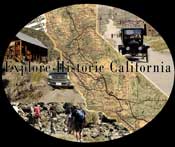Nine years after the initial gold discoveries in Randsburg
(circa 1904), the area had settled into a period of consistent
mining production. No new major gold discoveries had been made
and the easy finds had be thoroughly exploited. Big mining
companies ran the large lode mines such as the Yellow Aster and
miners worked for hourly wages ($3-$4 per day).
For years, miners and prospectors at the St. Elmo and other
mines in the Stringer district to the southeast had cursed a
heavy, creamy white substance that hindered their gold recovery.
They nicknamed this material "heavy spar" and left it at that.
What these miners had stumbled across was actually scheelite, a
tungsten ore. Tungsten is used to harden steel and as filaments
in incandescent light bulbs.
George Gaylord and Pat Burns recognized scheelite for what it
was in 1904. They traced the placer (streambed) deposits
northward but overlooked what would later be the Atolia veins.
They located scheelite lenses in the Stringer district, several
miles north of the where the Union mine would later be located.
The Papoose vein was discovered in an outcrop near the present
town of Atolia, and within a few months the Union deposits at
the west end of the field were discovered. The Papoose was the
leading scheelite mine in the world, 1908-1911.
Tungsten ore is sold and priced by the unit. A unit is 20 pounds
of ore containing 60 percent or more of tungsten trioxide. The
early strikes weren’t considered a big deal as tungsten was
selling for only about $6-$6.50 per unit.
The word, "Atolia" was derived from the contraction of names of
two area mining operators: Atkins and Degolia.
The Atolia Mining Co. was organized in 1905, and most of the
productive part of the district came under its control.
Depressed prices lead to a temporary shut down in 1911. The
following year, things were looking better. The Randsburg Miner
reported ( July 27, 1912) " The Atolia Miming Co., owners of the
Atolia tungsten mines, has enjoyed one of the most prosperous
periods in its history since the temporary shut-down about a
year ago. The tungsten market is good and the present market
price profitable for the producers.
Close to 100 men are now on the pay roll, and the crushing and
concentrating plant are kept in full operation running three
shifts.
The tungsten mines of the Atolia Mining company are the largest
individual tungsten producers in the United States, considering
the fact that the tungsten mines of Boulder county Colorado, are
operated by different companies."
By 1913 the district had produced more than $1-million worth of
ore.
World War I (1914-1918) caused tungsten prices to rise. Tungsten
was used to harden artillery shells, rifle barrels and armor.
Wartime prices brought thousands of miners into the district to
work the placer deposits of the "Spud Patch," so named because
the pieces of scheelite resembled potatoes. As many as 4000
people lived in the area, 1916-1918.
The major mine was the Union Mine, the deepest in the district
at about 1050-feet on the incline. The Union had six shafts and
several miles of underground workings.
The richness of the ore led to high-grading and to theft of
concentrates, and scheelite "spuds" were an acceptable medium of
exchange in the bars and stores of the region.
In 1916 the town of Atolia boasted four restaurants, three
general stores, a drug store, two stationary stores, two
shoemakers, one hotel, three rooming houses and several lodging
tents, four pool rooms, four barber shops, an ice cream parlor,
picture show, garage, three butcher shops, a newspaper, and new
school house for 60 pupils.
The Atolia Mining Co. produced more than 224,846 units, worth
slightly less than $6-million. Prices dropped in 1919 with the
end of the war and it became cheaper to import scheelite from
China than to mine it in Atolia.
Silver discoveries a few miles to the north in Red Mountain
sealed Atolia’s fate. The area was worked off and on through
WWII and Vietnam War. Atolia was, for many years, the No. 1 or
No. 2 U.S. tungsten producer with total production in excess of
$15-million.
